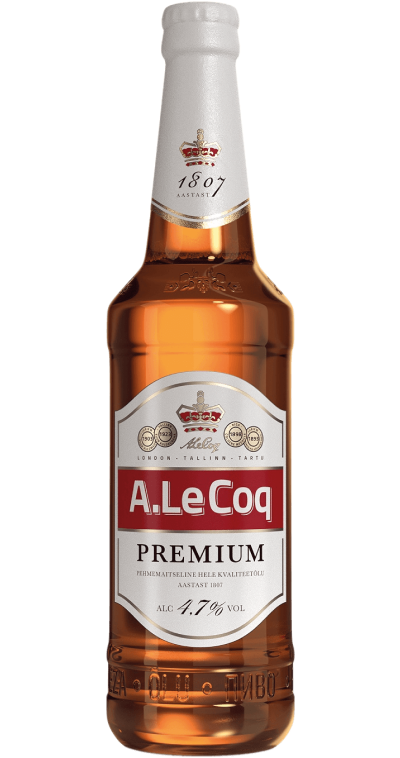
The Story of Beer
Beer is one of the most esteemed beverages in the world and also a form of sustenance, with roots dating back 12,000 years. As a drink, beer has allowed humanity to survive in extreme conditions, while as a food, it has been a part of people’s daily sustenance.
During times when drinking water was unsafe and even life-threatening, beer was considered completely pure and safe to consume. Through careful brewing and a long fermentation process, beer became a healthy and nourishing beverage. For example, during the construction of the Egyptian pyramids, beer was part of the daily food ration for the workers. This is likely one reason why beer continues to hold a respected place in the culinary traditions of various cultures.
In different countries around the world, including the city of Tartu, beer has played a significant socio-economic role. In 1783, the Brewmaster’s Guild was established in Tartu as a unique social welfare organization, with its members having exclusive rights to produce and sell beer in the city. Only widows and orphans of guild members could be members of the Brewmaster’s Guild. Beer trading also laid the foundation for the creation of the A. Le Coq brand in London in 1807. Thus, beer has not only been a delicious beverage but also a source of economic support and a field of activity for centuries.
Today, the world of beer is diverse and exciting, with hundreds of different beer styles. Each brewery’s beers, made from four natural ingredients – pure water, selected hops, special malts, and unique yeast – possess a distinct flavor profile and the brewmaster’s craftsmanship. Beer has become more than just a thirst quencher; it has become part of the culinary art, allowing us to enjoy the complexity and compatibility of different flavors and aromas with food.
It can be said that throughout history, beer has been a vital drink and food for humanity, with its importance and role extending beyond mere hydration. Brewing has become an art that brings together different cultures, traditions, and taste preferences. Consuming beer and non-alcoholic beer is part of our traditions, and it is something that brings joy when enjoyed in the company of friends today.
History of Beer Brewing in Estonia
The history of beer has been closely intertwined with the development of civilization and technological progress over centuries. The origins of beer production date back over 10,000 years to when grains were cultivated and beer was brewed. It is believed that prehistoric nomads brewed beer from grains even before learning to make bread. Archaeological findings in Estonia have determined that barley cultivation began around 1000 BCE, making the history of beer production in Estonia nearly 3000 years old.
For a long time, beer was an everyday beverage, primarily due to the lack of clean drinking water and the constant risk of epidemics in Estonian cities. The importance of beer as a drink grew during the Middle Ages when clean drinking water was scarce and sanitation conditions were rudimentary. Therefore, all aspects related to beer as a source of income were strictly regulated in medieval cities. For instance, beer production in the 13th century was subject to rules concerning wages and fines.
Beer was brewed in Estonian farmhouses for calendar holidays such as Christmas, St. Michael’s Day, Midsummer, and family events. Brewed beer was also offered as a sacrifice to ancestral spirits, household spirits, and nature spirits. St. Michael’s Day was a day of gratitude to all those who had worked on the farm during the summer. On this day, every respectable host brewed a barrel or two of beer. It was also customary for men to drink beer together before commencing significant work and after completing it.
The tradition of home brewing began to decline in the 19th century with the emergence of manor brewery kitchens and factories. Even in the 1930s, brewing farmhouse beer was an integral part of holidays and celebrations.
A technological breakthrough occurred in urban breweries in the 19th century with the introduction of steam boilers. The first brewery with steam boilers was built in Tartu in 1874. Steam boilers allowed for consistent temperatures during the brewing process, resulting in a more consistent taste across different batches of beer than ever before. Furthermore, the use of steam boilers significantly reduced the risk of fire, which had previously plagued breweries. Another important technological leap occurred with the introduction of electric power, enabling the invention of refrigeration machines that produced the necessary artificial cold for cooling beer wort. Prior to that, for quick cooling of beer wort, breweries like A. Le Coq would use ice collected from the Emajõgi River during winter, which could be stored and utilized in deep cellars built into the slopes of Tähtvere hill until late autumn. Today, modern cooling systems in breweries ensure the quality and precision of different batches of beer.
Thus, the taste of Estonian beer has evolved along with beer technology, which has always been closely linked to general technological advancements. In addition to the introduction of steam boilers and electricity, subsequent inventions have brought about their own beer revolution. In the early 20th century, pasteurization was introduced, allowing for extended shelf life and reducing rapid spoilage of beer due to bacteria. Around the same time, beer filtration was implemented to remove small particles from the beer, ensuring its clarity and appearance.
While the beer-making process itself has not changed over the centuries, the technology has. Today, beer production in Estonia has reached a technologically advanced level, ensuring absolute stability in taste across all batches of the same variety. Modern Estonian breweries such as A. Le Coq and Saku completely upgraded their facilities in the 1990s, resulting in improved taste and increasing the shelf life of bottled beer from seven days to a year.
Ultimately, taste is what matters. Like people around the world, Estonians prefer lager beer, which offers refreshment and enjoyment. Consumers are also increasingly exploring craft beers, specialty brews, and non-alcoholic beer. As a result, home brewing and small breweries have become integral parts of Estonian beer culture and its diversity.
The long history of beer production is preserved in Tartu’s Õllemaailm, located in the historic malt drying tower of the A. Le Coq factory. Õllemaailm serves as both a museum and an experiential center, providing visitors with a glimpse into the 12,000-year history of beer culture as well as an overview of A. Le Coq’s groundbreaking years and the company’s development into a modern beverage industry.
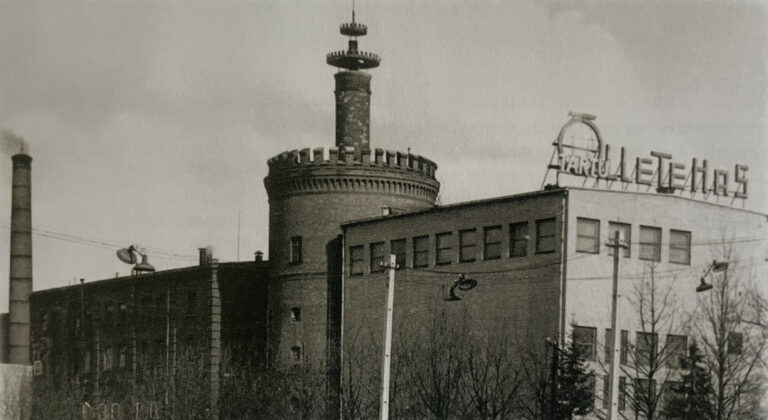
How is Beer Brewed
Our brewers know that in addition to the best hops and malt, you also have to put some soul into beer. This is the little secret that makes A. Le Coq beers so special. However, we’re happy to share our modern beer-making technology with you. Just watch the video below.
Types of Beer
Beers are divided according to the type of yeast used for fermentation:
Bottom- Fermented Beer of Lagers
Bottom fermentation means fermentation at a lower temperature (7–12 °C) and for longer than top fermentation (2–3 weeks);
The yeast settles on the bottom of the vessel at the end of fermentation;
The result is a lager.
Pale Lager
As a rule, pale lager is clear and easy to drink;
The aroma and flavour are crisply fresh and hoppy with a slightly bitter undertone;
Suggested serving temperature is 6–8 °C.
Pale lagers are, for example:
A. Le Coq Premium is a crisp and easily drinkable beer, in which the soft taste is balanced well by a slightly sweet character and the freshness of hops. A. Le Coq Premium pairs well with lighter dishes and savory snacks, such as garlic bread, potato chips, BBQ meat, and spicy Asian and Mexican cuisine.
Dark Lager
Dark reddish-brown beer;
The taste is dominated by roasted malt, black bread and/or caramel;
Suggested serving temperature is 12–16 °C.
Dark lagers are, for example:
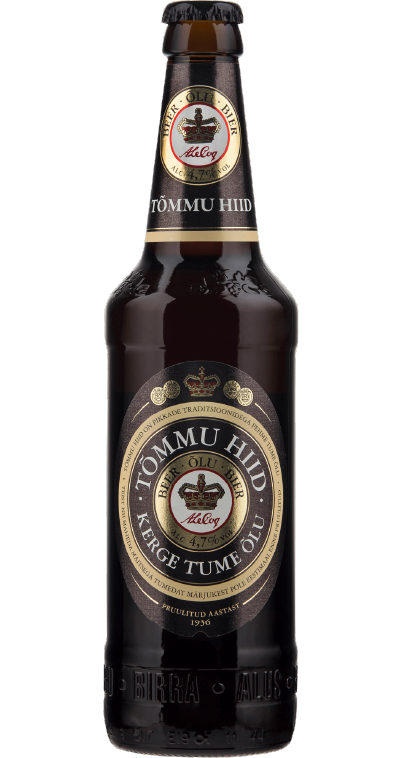
A. Le Coq Porter is a medium-bodied dark beer with flavors of intense roasted caramel, dried fruits, and bitter chocolate. It pairs well with richer and heavier dishes and desserts such as baked casseroles, chocolate, caramel, and stronger cheeses.
Tõmmu Hiid is a light, smooth-tasting dark beer. It pairs well with moderately filling foods such as BBQ meat and grilled chicken, hot-smoked fish, classic Estonian cheeses, and goulash.
Top- Fermented Beer or Ales
Top fermentation takes place at a higher temperature than bottom fermentation;
The heat, which depending on the yeast strain is usually from 15–25°C, makes the beer ferment quickly and strongly;
The yeast rises to the top at the end of fermentation and the result is an ale.
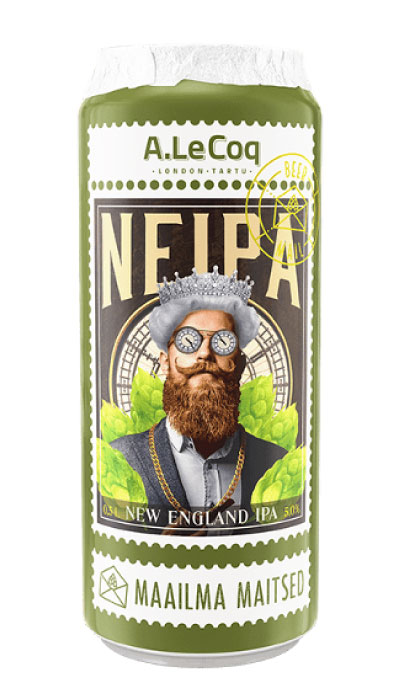
Light Ale
The colour varies from light amber to reddish-brown;
The taste is rather full and, depending on the beer, may contain hints of caramel, light fruitiness and bread.
Light ales are, for example:
A. Le Coq NEIPA is an ultra-fresh, light ale-style beer with a strong citrus and tropical fruit flavor (pineapple, lychee, melon, and apricot), accompanied by a moderate hop aroma.
We recommend serving the ale with dishes such as grilled ribs, potato dishes, and pizza. It also pairs well with Mexican cuisine and hard cheeses.
Dark Ale: Porter and Stout
Porter was developed in England and became popular with port labourers, which is what gave the beer its name;
The colour may vary from brown to black;
The taste is usually rich with hints of caramel, coffee and chocolate.
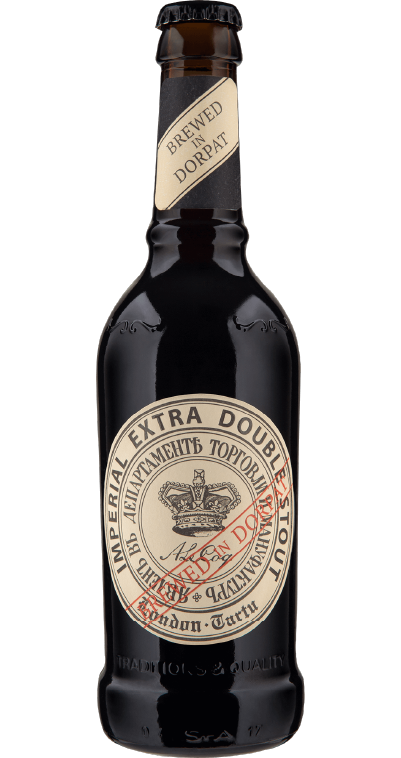
Stout is a rich, dark beer with a thick brown foam. It is characterized by a prominent flavor of heavily roasted barley malt and features notes of oak, autumn berries, and sherry, which are typical of the style.
Stout is well-suited for enjoyment alongside hearty stews, ribs, hard cheeses, and desserts.
Beer Fermented with Wild Yeast
Beer fermented with wild yeast is known as lambic. So-called spontaneous fermentation occurs due to the impact of the ‘wild’ microorganisms found in the air. Lambic takes up to three years to mature. The best-known lambic beers are kriek and framboise, which are made using cherries (kriek) or raspberries (framboise).
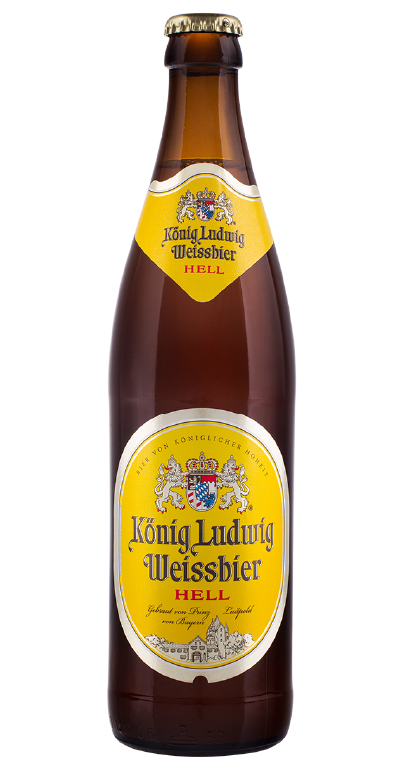
Wheat Beer (Weizen or Weissbier)
Wheat beer contains around 50% of wheat, in addition to barley malt;
Wheat beers may be dark or pale. Light wheat beer is known as Weizen (wheat beer) in Western and Northern Germany, and as Weissbier (white beer) or Weisse in Bavaria;
The beer tastes fruity, lightly spicy and malty.
Wheat beer is, for example:
König Ludwig Weissbier is a straw-yellow beer with a slightly cloudy appearance and a thick, dense foam. The aromas are intense, with initial notes of exotic clove and banana, complemented by subtle citrus tones. The taste is refreshingly acidic and fruity, with a lingering subtle acidity and vibrant spiciness in the aftertaste. Wheat beer is intended for those who prefer freshness over hop bitterness.
König Ludwig Weissbier pairs well with grilled fish and chicken, Viennese schnitzel, and various salads, such as the classic Caesar salad.
Beer and Food
Beer is highly versatile and diverse in its flavor profile, offering both complementary and pleasantly contrasting flavors when paired with food.
When pairing beer with food, the principle is to look for similar flavors in the beer and the dish. Lighter dishes pair well with lighter beers, while more complex dishes require a more intricate beer. Fatty foods benefit from stronger flavors and higher alcohol content in the beer. The only exception is that bitterness doesn’t pair well with bitterness; bitter foods require a fruity beverage.
GOLDEN RULES OF FLAVOR PAIRING
- Salty food – fruity or acidic beer, such as ale
- Spicy food – bitter or light beer, such as IPA or light lager
- Sour food – more acidic or bitter beer, such as pilsner or IPA
- Sweet food – sweet beer, such as porter
- Light food – lighter beer, such as light lager
- Complex food – beer with a wide range of flavors, such as wheat beer
- Fatty food – beer with strong flavors and higher alcohol content, such as stout
How to Serve Beer
The most important thing when serving beer professionally is the right temperature. The right flavour nuances of the beer are lost when it is served too cold or too warm.
At home, you can cool a lager that’s at room temperature (ca 20 °C) down to the right temperature by putting the bottle in the fridge for 2.5 hours or in the freezer for 25 minutes. You can cool a dark beer down to 16 degrees at home by putting it in the fridge for about 20 minutes.
If you put the beer in the freezer, use the alarm function on your phone or a timer, because a beer bottle will break if left in the freezer for too long.
You should also use the right glass with the right beer. Lager is usually served from a tall and narrow pilsner glass or a mug. Footed pilsner glasses are also used to serve smaller quantities.
We recommend serving dark beer from tulip-shaped glasses. This allows the beer to get more air and the drinker gets a better sense of the rich aroma of dark beer.
A beer glass is meant only for beer. The beer will not develop a proper head if the glass is not properly washed or there are even tiny bits of fat residue in it. Depending on the type of the beer, it is served with a 2–3 cm head. The right head helps the drink stay fresh for a long time and to preserve its taste. The consistency of the head should be thick and it should consist of tiny bubbles. The main preconditions for achieving this are the correct temperature of the beer and a clean glass, but the pouring angle is also very important.
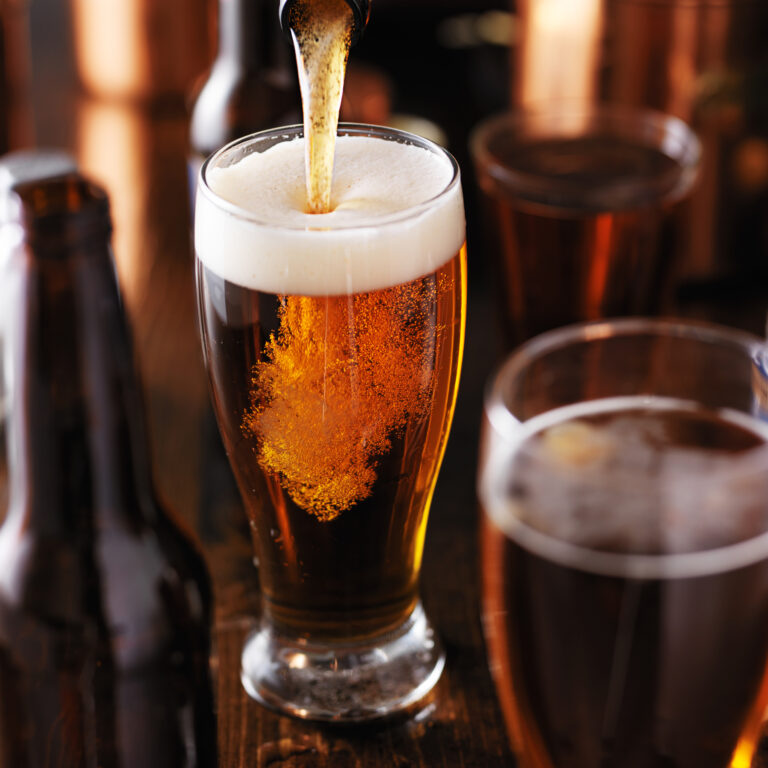
When you serve beer at home, start pouring it calmly whilst holding the glass at a 45-degree angle. Pour the beer from a height of ca 2 cm and aim the stream at the middle part of the inner wall of the glass. After filling half the glass, turn it upright and continue pouring the beer until the head reaches the brim of the glass.
Serving Pale Lager from a Tap

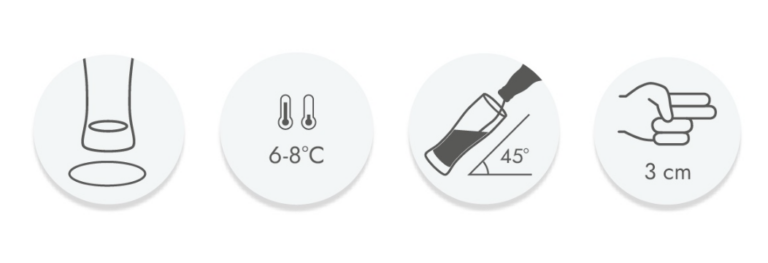
- Use a tall, narrow glass for serving
- Make sure that the glass is clean
- Place the glass under the tap at a 45-degree angle and open the tap
- When three quarters of the glass is full, turn it upright and pour a 2–3 cm head on the glass by pushing the tap backwards
- Serve the beer quickly before the head goes down
- Place a coaster under the glass when serving
Serving Dark Lager

- Use a tulip-shaped beer glass
- Make sure that the glass is clean and dry
- The recommended serving temperature is 12–16 °C.
- Place the glass on a coaster and fill half of it
- Make sure that a nice 2 cm head develops on the beer
- Place a coaster under the glass when serving
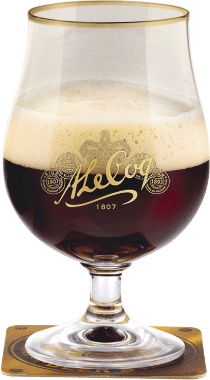
Serving Ales
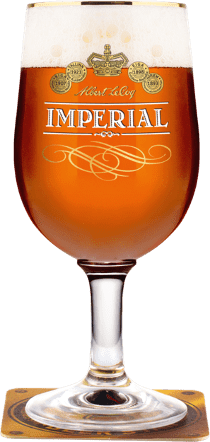

- Use the correct, preferably a footed glass for serving
- Make sure that the glass is clean and dry
- The recommended serving temperature is 10–12 °C
- Place the glass on a coaster and pour in the beer
- Make sure that a nice 2 cm head develops on the beer
- Place a coaster under the glass when serving
Serving Wheat Beer

- Wheat beer should be served at a temperature of 5–7 °C
- Wheat beer bottles must be stored upright so that the yeast can settle on the bottom
- Hold the glass at a 45-degree angle when pouring
- Pour the beer slowly into the glass
- Leave ca 1–2 cm of beer and yeast in the bottom of the bottle
- Swirl the bottle lightly to mix the beer and the yeast, then pour a 2–3 cm head on the beer
- Place a coaster under the glass when serving
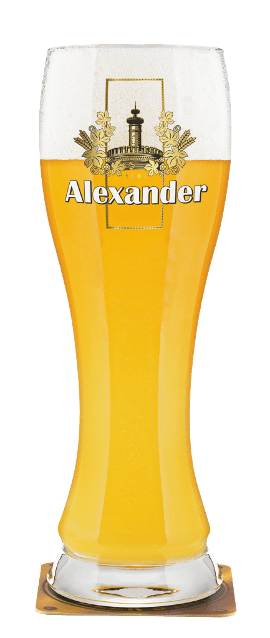
Responsible Consumption
As Estonia’s leading beverage manufacturer, we take responsibility towards society by supporting initiatives that emphasize zero tolerance for alcohol consumption among minors, while driving, or during pregnancy. In our marketing activities and product labeling, we emphasize the inappropriateness of alcoholic beverages in the aforementioned situations.
Become a Sober Group Leader with alcohol-free A. Le Coq Premium
In order to ensure that the summer solstice is a fun event for everyone, we have supported the Sober Group Leader campaign initiated by Radio Kuku with our alcohol-free beer for years and invite everyone to join.
The Sober Group Leader acts as a sober driver for their friends during St. John’s Day celebrations and ensures that nobody gets behind the wheel after having a drop of the hard stuff. To make sure that they can still have beer on St. John’s Day, A. Le Coq offers Sober Group Leaders alcohol-free Premium and Fassbrause.
Sign up as a Sober Group Leader before St. John’s Day and be the friend who helps prevent drunk driving in your social circle.
What is responsible consumption?
It is not possible to define a completely safe or universally applicable level of moderate alcohol consumption. However, based on scientific research, experts have identified quantity-based limits for healthy adults, exceeding which health risks increase significantly.
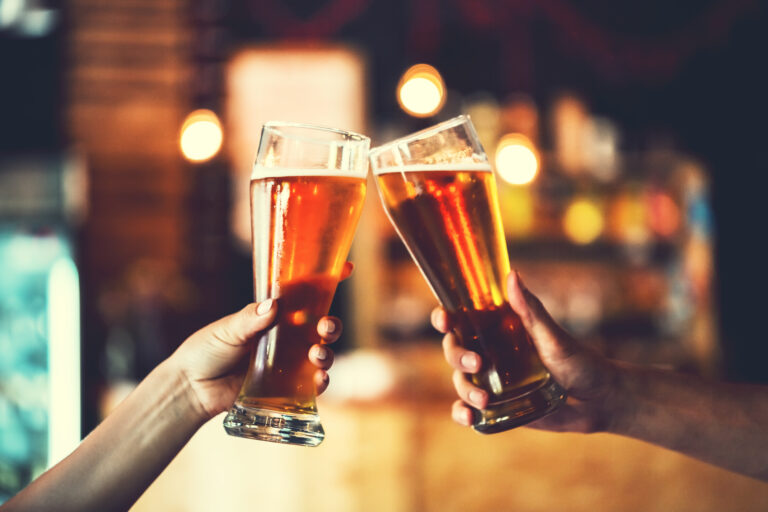
In order for people to make informed decisions about alcohol consumption, guidelines have been developed in many countries, presented as daily or weekly quantities. In recent years, due to newer scientific research, several countries have lowered their risk limits. Since 2021, Estonia has implemented new low-risk alcohol consumption limits for healthy adults:
- Men: Up to 14 alcohol units per week, averaging 2 alcohol units per day.
- Women: Up to 7 alcohol units per week, averaging 1 alcohol unit per day.
- The weekly limit should not be consumed all at once or during the weekend.
1 alcohol unit = 10 grams of pure alcohol. For example, one alcohol unit is equivalent to 282 ml of 4.5% cider, 244 ml of 5.2% beer, 32 ml of a shot of strong spirits at 40% alcohol, or 106 ml of 12% wine.
Source: Alkoinfo.ee

